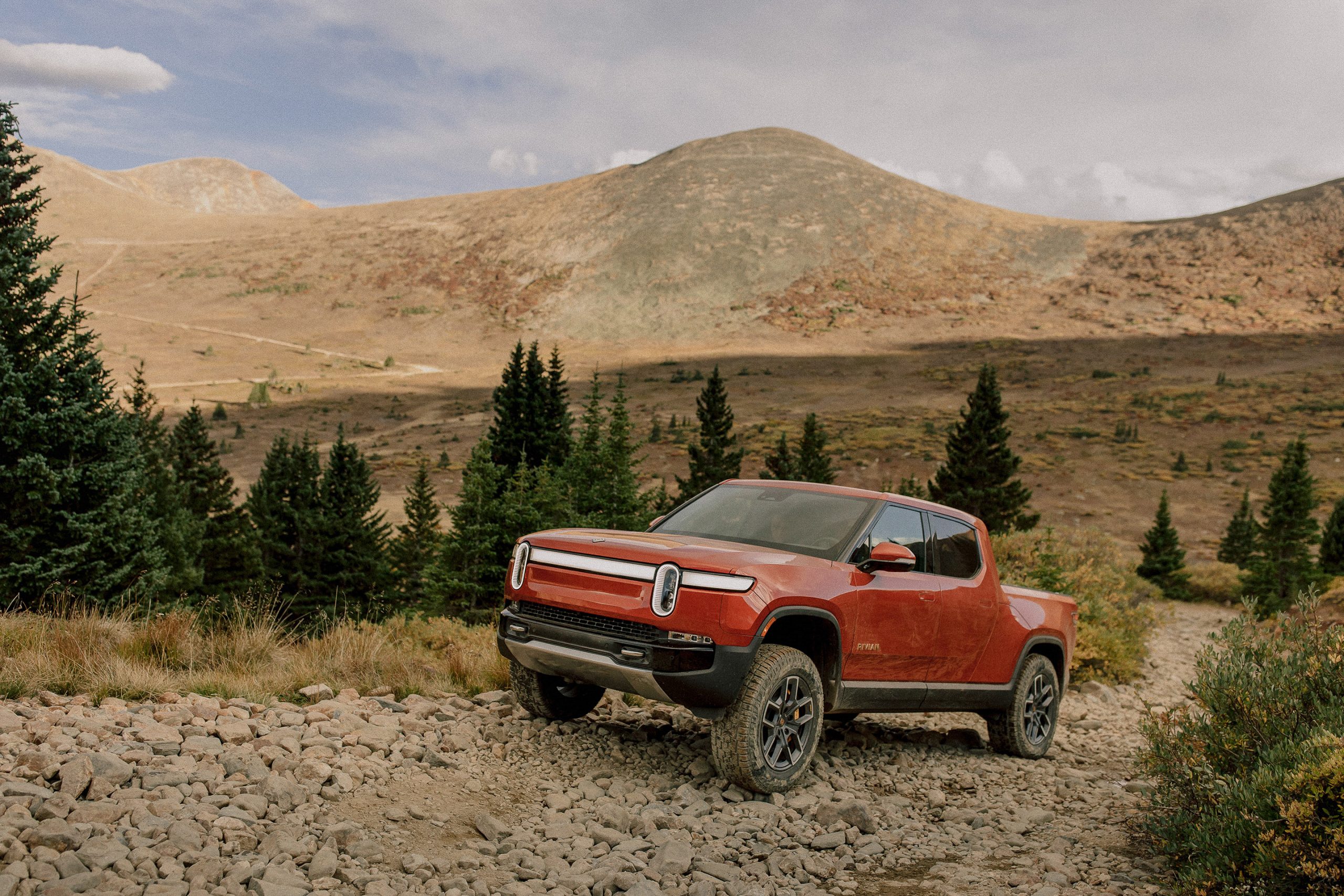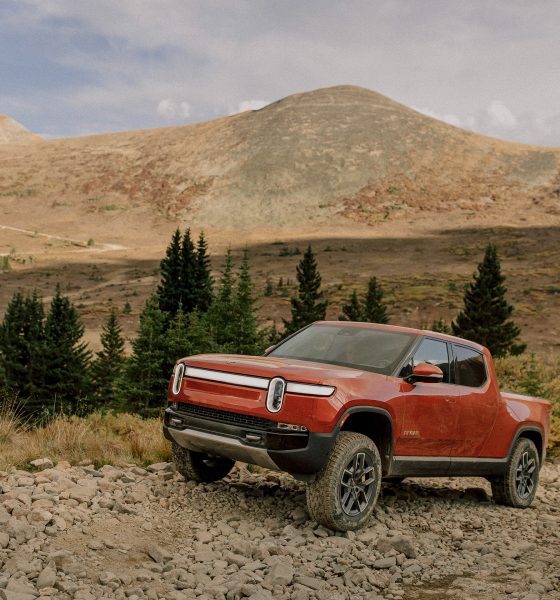UPDATED 1:13 PM EST: Revised IPO opening to 52% from 60%.
Rivian Automotive (NASDAQ: RIVN) is set for its market debut today with an implied valuation of over $93 billion thanks to an over 52% surge in share price from its IPO price of $78 per share.
The most recent developments for the Rivian market debut have set the company’s initial share price at $122 per share, which could put the company’s valuation at around $104 billion. This would make Rivian the sixth-most valuable automaker globally, displacing General Motors with a market cap of $85.92 billion. Rivian would be slightly behind Daimler, which holds a valuation of $109.12 billion.
Earlier this week, Rivian priced its shares for its IPO at between $75 and $78, above its previously expected range. The automaker expected to raise $11.9 billion, making it the second-largest tech IPO of all time, trailing Facebook who raised $16 billion in May 2012.
Rivian’s valuation may be driven by the sentiment trailing its name, which is backed by high-end and well-known investors like Amazon and Ford. During a disclosure earlier this month, Amazon disclosed its 20% ownership position in Rivian, which will produce 100,000 all-electric e-commerce delivery vehicles for the company. The Rivian delivery vans have already been tested in various cities across the United States. The 100,000 deliveries will take place by 2030, with 10,000 units operating by the end of 2022.
Rivian announces a $2.5B funding round, bringing grand total to $10.5B
Rivian is entering an EV market that is becoming more populated with every quarter. Both existing, legacy automotive companies and new, tech-focused startups are attempting to establish new EVs that will dethrone the undisputed king of the sector, Tesla. Rivian, while delivering around 150 units of its introductory R1T as of November 1, is the first automaker to introduce an all-electric pickup to the market. It will have tough competition to fend off as Ford will roll out the F-150 Lightning in Spring 2022. GMC’s Hummer EV is expected to begin deliveries later this year, and the widely-popular Tesla Cybertruck is set to start production in late 2022.
150,000 all-electric vehicles are expected to roll off Rivian’s production lines at its manufacturing facility in Normal, Illinois, annually. Along with the R1T and Amazon delivery vans, Rivian is developing the R1S, an all-electric SUV that could begin deliveries as soon as December, the company’s prospectus said. Rivian also stated that it has 9,500 employees, with over 3,400 of them working at the Normal Factory.
Rivian will have an uphill battle for the remainder of 2021, as it said in the October prospectus. Revenue has not been generated due to its process of ramping current vehicle production, which is costly and challenging to scale. Tesla CEO Elon Musk advised Rivian to ramp and solve production at its single Normal, Illinois factory for the time being. However, rumors of a manufacturing expansion known as “Project Terra” have swirled through the sector, with several U.S. states, including Texas, being discussed as a possible landing spot for Rivian’s second production plant.
Disclosure: Joey Klender is not a RIVN Shareholder.
I’d love to hear from you! If you have any comments, concerns, or questions, please email me at joey@teslarati.com. You can also reach me on Twitter @KlenderJoey, or if you have news tips, you can email us at tips@teslarati.com.

News
Tesla FSD fleet is nearing 7 billion total miles, including 2.5 billion city miles
As can be seen on Tesla’s official FSD webpage, vehicles equipped with the system have now navigated over 6.99 billion miles.

Tesla’s Full Self-Driving (Supervised) fleet is closing in on almost 7 billion total miles driven, as per data posted by the company on its official FSD webpage.
These figures hint at the massive scale of data fueling Tesla’s rapid FSD improvements, which have been quite notable as of late.
FSD mileage milestones
As can be seen on Tesla’s official FSD webpage, vehicles equipped with the system have now navigated over 6.99 billion miles. Tesla owner and avid FSD tester Whole Mars Catalog also shared a screenshot indicating that from the nearly 7 billion miles traveled by the FSD fleet, more than 2.5 billion miles were driven inside cities.
City miles are particularly valuable for complex urban scenarios like unprotected turns, pedestrian interactions, and traffic lights. This is also the difference-maker for FSD, as only complex solutions, such as Waymo’s self-driving taxis, operate similarly on inner-city streets. And even then, incidents such as the San Francisco blackouts have proven challenging for sensor-rich vehicles like Waymos.
Tesla’s data edge
Tesla has a number of advantages in the autonomous vehicle sector, one of which is the size of its fleet and the number of vehicles training FSD on real-world roads. Tesla’s nearly 7 billion FSD miles then allow the company to roll out updates that make its vehicles behave like they are being driven by experienced drivers, even if they are operating on their own.
So notable are Tesla’s improvements to FSD that NVIDIA Director of Robotics Jim Fan, after experiencing FSD v14, noted that the system is the first AI that passes what he described as a “Physical Turing Test.”
“Despite knowing exactly how robot learning works, I still find it magical watching the steering wheel turn by itself. First it feels surreal, next it becomes routine. Then, like the smartphone, taking it away actively hurts. This is how humanity gets rewired and glued to god-like technologies,” Fan wrote in a post on X.
News
Tesla starts showing how FSD will change lives in Europe
Local officials tested the system on narrow country roads and were impressed by FSD’s smooth, human-like driving, with some calling the service a game-changer for everyday life in areas that are far from urban centers.

Tesla has launched Europe’s first public shuttle service using Full Self-Driving (Supervised) in the rural Eifelkreis Bitburg-Prüm region of Germany, demonstrating how the technology can restore independence and mobility for people who struggle with limited transport options.
Local officials tested the system on narrow country roads and were impressed by FSD’s smooth, human-like driving, with some calling the service a game-changer for everyday life in areas that are far from urban centers.
Officials see real impact on rural residents
Arzfeld Mayor Johannes Kuhl and District Administrator Andreas Kruppert personally tested the Tesla shuttle service. This allowed them to see just how well FSD navigated winding lanes and rural roads confidently. Kruppert said, “Autonomous driving sounds like science fiction to many, but we simply see here that it works totally well in rural regions too.” Kuhl, for his part, also noted that FSD “feels like a very experienced driver.”
The pilot complements the area’s “Citizen Bus” program, which provides on-demand rides for elderly residents who can no longer drive themselves. Tesla Europe shared a video of a demonstration of the service, highlighting how FSD gives people their freedom back, even in places where public transport is not as prevalent.
What the Ministry for Economic Affairs and Transport says
Rhineland-Palatinate’s Minister Daniela Schmitt supported the project, praising the collaboration that made this “first of its kind in Europe” possible. As per the ministry, the rural rollout for the service shows FSD’s potential beyond major cities, and it delivers tangible benefits like grocery runs, doctor visits, and social connections for isolated residents.
“Reliable and flexible mobility is especially vital in rural areas. With the launch of a shuttle service using self-driving vehicles (FSD supervised) by Tesla in the Eifelkreis Bitburg-Prüm, an innovative pilot project is now getting underway that complements local community bus services. It is the first project of its kind in Europe.
“The result is a real gain for rural mobility: greater accessibility, more flexibility and tangible benefits for everyday life. A strong signal for innovation, cooperation and future-oriented mobility beyond urban centers,” the ministry wrote in a LinkedIn post.
News
Tesla China quietly posts Robotaxi-related job listing
Tesla China is currently seeking a Low Voltage Electrical Engineer to work on circuit board design for the company’s autonomous vehicles.

Tesla has posted a new job listing in Shanghai explicitly tied to its Robotaxi program, fueling speculation that the company is preparing to launch its dedicated autonomous ride-hailing service in China.
As noted in the listing, Tesla China is currently seeking a Low Voltage Electrical Engineer to work on circuit board design for the company’s autonomous vehicles.
Robotaxi-specific role
The listing, which was shared on social media platform X by industry watcher @tslaming, suggested that Tesla China is looking to fill the role urgently. The job listing itself specifically mentions that the person hired for the role will be working on the Low Voltage Hardware team, which would design the circuit boards that would serve as the nervous system of the Robotaxi.
Key tasks for the role, as indicated in the job listing, include collaboration with PCB layout, firmware, mechanical, program management, and validation teams, among other responsibilities. The role is based in Shanghai.
China Robotaxi launch
China represents a massive potential market for robotaxis, with its dense urban centers and supportive policies in select cities. Tesla has limited permission to roll out FSD in the country, though despite this, its vehicles have been hailed as among the best in the market when it comes to autonomous features. So far, at least, it appears that China supports Tesla’s FSD and Robotaxi rollout.
This was hinted at in November, when Tesla brought the Cybercab to the 8th China International Import Expo (CIIE) in Shanghai, marking the first time that the autonomous two-seater was brought to the Asia-Pacific region. The vehicle, despite not having a release date in China, received a significant amount of interest among the event’s attendees.










